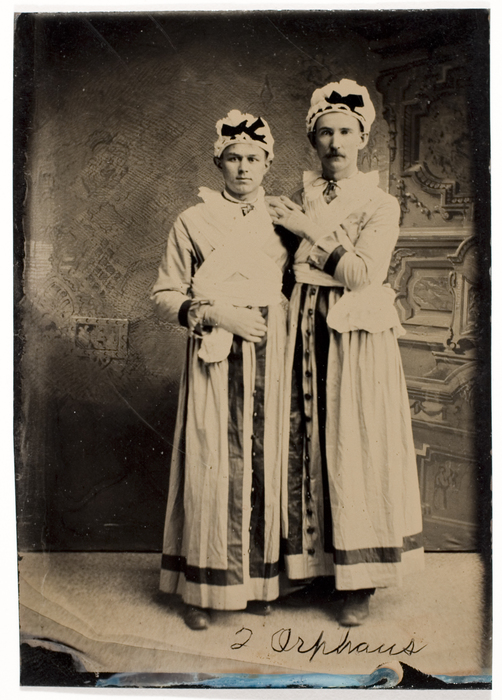One of the most intriguing and little studied forms of nineteenth-century photography is the tintype. Introduced in 1856 as a low-cost alternative to the daguerreotype and the albumen print, the tintype was widely marketed from the 1860s through the first decades of the twentieth century as the cheapest and most popular photographic medium. Because of its ubiquity, the tintype provides a startlingly candid record of the political upheavals that rocked in the four decades following the American Civil War, and the personal anxieties they induced. The tintype studio became a kind of performance space where sitters could act out their personal identities, displaying the tools of their trade, masks and costumes, toys and dolls, stuffed animals, and props of all sorts. This uniquely American medium provides extraordinary insights into the development of national attitudes and characteristics in the formative years of the early modern era. The exhibition, organized by ICP Chief Curator Brian Wallis and guest curator Steven Kasher, includes over 150 remarkable examples of tintypes drawn from the Permanent Collection.
118 Items



![[Unidentified Invalid Girl with Woman and Cloaked Attendant]](https://s3.amazonaws.com/icptmsdata/u/n/i/d/unidentified_photographer_74_2004_418185_displaysize.jpg)
![[Unidentified Invalid Girl in Wheelchair with Cloaked Attendant]](https://s3.amazonaws.com/icptmsdata/u/n/i/d/unidentified_photographer_75_2004_448797_displaysize.jpg)
![[Unidentified Bare-Chested Man]](https://s3.amazonaws.com/icptmsdata/u/n/i/d/unidentified_photographer_73_2004_445783_displaysize.jpg)
![[Private Benjamin F. Smith, 11th U.S. Infantry]](https://s3.amazonaws.com/icptmsdata/u/n/i/d/unidentified_photographer_78_2004_455953_displaysize.jpg)
![[Unidentified Woman Holding a Tintype of a Man]](https://s3.amazonaws.com/icptmsdata/u/n/i/d/unidentified_photographer_2415_2005_424757_displaysize.jpg)
![[Three Unidentified Women in Mourning Dress Reading a Letter]](https://s3.amazonaws.com/icptmsdata/u/n/i/d/unidentified_photographer_2007_54_29_434143_displaysize.jpg)
![[Unidentified Child]](https://s3.amazonaws.com/icptmsdata/o/l/m/s/olmsted_79_2004_446183_displaysize.jpg)
![[Two Unidentified Men with Map of the United States]](https://s3.amazonaws.com/icptmsdata/u/n/i/d/unidentified_photographer_76_2004_461795_displaysize.jpg)
![[Unidentified Girl with American Flag]](https://s3.amazonaws.com/icptmsdata/u/n/i/d/unidentified_photographer_2007_54_16_458652_displaysize.jpg)
![[Unidentified Man Posing with Five Men in Native American Dress]](https://s3.amazonaws.com/icptmsdata/u/n/i/d/unidentified_photographer_2417_2005_408235_displaysize.jpg)
![[Backs of Unidentified Woman and Man Holding Letter]](https://s3.amazonaws.com/icptmsdata/u/n/i/d/unidentified_photographer_2416_2005_441057_displaysize.jpg)
![[Hand Reaching Toward Unidentified Woman and Man Holding Bottle]](https://s3.amazonaws.com/icptmsdata/u/n/i/d/unidentified_photographer_2007_54_14_420422_displaysize.jpg)
![[Double Exposure of Unidentified Boy]](https://s3.amazonaws.com/icptmsdata/u/n/i/d/unidentified_photographer_2411_2005_464261_displaysize.jpg)
![[Unidentified Man Leading Man Wearing a Mask and Holding a Cane]](https://s3.amazonaws.com/icptmsdata/u/n/i/d/unidentified_photographer_2007_54_2_462574_displaysize.jpg)
![[Nanny and Child]](https://s3.amazonaws.com/icptmsdata/u/n/i/d/unidentified_photographer_71_2004_421025_displaysize.jpg)
![[Two Unidentified Men, Each with a Child on His Lap]](https://s3.amazonaws.com/icptmsdata/u/n/i/d/unidentified_photographer_2007_54_1_449100_displaysize.jpg)
![[Three Metalworkers]](https://s3.amazonaws.com/icptmsdata/u/n/i/d/unidentified_photographer_2007_54_23_422560_displaysize.jpg)
![[Unidentified Freedwoman]](https://s3.amazonaws.com/icptmsdata/u/n/i/d/unidentified_photographer_67_2004_460549_displaysize.jpg)
![[Two Unidentified Men]](https://s3.amazonaws.com/icptmsdata/u/n/i/d/unidentified_photographer_68_2004_414236_displaysize.jpg)
![[Unidentified Young Man with Bandaged Head]](https://s3.amazonaws.com/icptmsdata/u/n/i/d/unidentified_photographer_2007_54_5_415734_displaysize.jpg)
![[Three Minstrels in Blackface]](https://s3.amazonaws.com/icptmsdata/u/n/i/d/unidentified_photographer_2007_54_22_446091_displaysize.jpg)
![[Three Costumed Performers]](https://s3.amazonaws.com/icptmsdata/u/n/i/d/unidentified_photographer_2007_54_27_456817_displaysize.jpg)
![[Two Unidentified Boys with Tambourine]](https://s3.amazonaws.com/icptmsdata/u/n/i/d/unidentified_photographer_2007_54_10_460046_displaysize.jpg)
![[Unidentified Woman in Chains with SLAVE Embroidered on Dress]](https://s3.amazonaws.com/icptmsdata/u/n/i/d/unidentified_photographer_69_2004_446856_displaysize.jpg)
![[Unidentified Woman in Chains with SLAVE Embroidered on Dress]](https://s3.amazonaws.com/icptmsdata/u/n/i/d/unidentified_photographer_70_2004_461709_displaysize.jpg)
![[Two Unidentified Women]](https://s3.amazonaws.com/icptmsdata/u/n/i/d/unidentified_photographer_82_2004_416385_displaysize.jpg)
![[Iceman]](https://s3.amazonaws.com/icptmsdata/u/n/i/d/unidentified_photographer_2007_54_9_447500_displaysize.jpg)
![[Unidentified Boy with Gun]](https://s3.amazonaws.com/icptmsdata/u/n/i/d/unidentified_photographer_2007_54_25_464371_displaysize.jpg)
![[Four Hanging Heads]](https://s3.amazonaws.com/icptmsdata/u/n/i/d/unidentified_photographer_2007_54_6_422320_displaysize.jpg)
![[Unidentified Girl with Parrot and Doll]](https://s3.amazonaws.com/icptmsdata/u/n/i/d/unidentified_photographer_2007_54_3_421638_displaysize.jpg)
![[Two Boxers]](https://s3.amazonaws.com/icptmsdata/w/i/l/l/williscroft_george_64_2004_439078_displaysize.jpg)

![[Two Unidentified Men Posing in a Picture Frame]](https://s3.amazonaws.com/icptmsdata/u/n/i/d/unidentified_photographer_2007_54_26_429917_displaysize.jpg)
![[Backs of Eight Unidentified Women with Long Hair]](https://s3.amazonaws.com/icptmsdata/u/n/i/d/unidentified_photographer_2413_2005_457537_displaysize.jpg)
![[Unidentified Man with Picture of Horse]](https://s3.amazonaws.com/icptmsdata/u/n/i/d/unidentified_photographer_2007_54_19_462169_displaysize.jpg)
![[Family of Cobblers]](https://s3.amazonaws.com/icptmsdata/u/n/i/d/unidentified_photographer_2007_54_12_433744_displaysize.jpg)
![[Butcher]](https://s3.amazonaws.com/icptmsdata/u/n/i/d/unidentified_photographer_2007_54_4_439251_displaysize.jpg)
![[Two Waiters]](https://s3.amazonaws.com/icptmsdata/u/n/i/d/unidentified_photographer_2007_54_7_455760_displaysize.jpg)
![[Unidentified Man in Carriage with Horse Wearing Harness to Drive Away Flies]](https://s3.amazonaws.com/icptmsdata/u/n/i/d/unidentified_photographer_2007_54_15_451514_displaysize.jpg)
![[Two Clowns]](https://s3.amazonaws.com/icptmsdata/u/n/i/d/unidentified_photographer_2007_54_30_440766_displaysize.jpg)
![[Carpenter]](https://s3.amazonaws.com/icptmsdata/u/n/i/d/unidentified_photographer_66_2004_447555_displaysize.jpg)
![[Blacksmith]](https://s3.amazonaws.com/icptmsdata/u/n/i/d/unidentified_photographer_77_2004_429553_displaysize.jpg)
![[Unidentified Man Covered with "Shoofly" Flyers]](https://s3.amazonaws.com/icptmsdata/u/n/i/d/unidentified_photographer_2007_54_13_444832_displaysize.jpg)
![[Unidentified Man and Woman with Horses and Plow]](https://s3.amazonaws.com/icptmsdata/u/n/i/d/unidentified_photographer_2007_54_24_456978_displaysize.jpg)
![[Two Clowns on Stilts]](https://s3.amazonaws.com/icptmsdata/u/n/i/d/unidentified_photographer_2412_2005_430255_displaysize.jpg)
![[Unidentified Man Missing Two Fingers]](https://s3.amazonaws.com/icptmsdata/u/n/i/d/unidentified_photographer_2007_54_11_416104_displaysize.jpg)
![[Apple Vendor]](https://s3.amazonaws.com/icptmsdata/u/n/i/d/unidentified_photographer_2007_54_20_419176_displaysize.jpg)
![[Acrobat]](https://s3.amazonaws.com/icptmsdata/u/n/i/d/unidentified_photographer_65_2004_409454_displaysize.jpg)
![[Farrier]](https://s3.amazonaws.com/icptmsdata/u/n/i/d/unidentified_photographer_2007_54_17_412802_displaysize.jpg)
![[Three Blacksmiths]](https://s3.amazonaws.com/icptmsdata/u/n/i/d/unidentified_photographer_2410_2005_450357_displaysize.jpg)
![[Two Domestic Workers]](https://s3.amazonaws.com/icptmsdata/u/n/i/d/unidentified_photographer_72_2004_436934_displaysize.jpg)
![[Farrier]](https://s3.amazonaws.com/icptmsdata/w/e/e/s/weese_fred_81_2004_440397_displaysize.jpg)
![[Two Acrobats]](https://s3.amazonaws.com/icptmsdata/u/n/i/d/unidentified_photographer_80_2004_422291_displaysize.jpg)
![[Mechanic]](https://s3.amazonaws.com/icptmsdata/u/n/i/d/unidentified_photographer_2414_2005_454423_displaysize.jpg)
![[Three Salvation Army Soldiers with Copies of War Cry]](https://s3.amazonaws.com/icptmsdata/u/n/i/d/unidentified_photographer_2419_2005_455389_displaysize.jpg)
![[Newsboys in Front of Hotel]](https://s3.amazonaws.com/icptmsdata/u/n/i/d/unidentified_photographer_2007_54_28_417434_displaysize.jpg)
![[Unidentified Man and Two Women Levitating]](https://s3.amazonaws.com/icptmsdata/u/n/i/d/unidentified_photographer_2007_54_8_410819_displaysize.jpg)
![[Banjo Player]](https://s3.amazonaws.com/icptmsdata/u/n/i/d/unidentified_photographer_2418_2005_431766_displaysize.jpg)
![[Unidentified Man Smoking a Cigar]](https://s3.amazonaws.com/icptmsdata/u/n/i/d/unidentified_photographer_2007_54_21_435908_displaysize.jpg)
![[Two Baseball Players]](https://s3.amazonaws.com/icptmsdata/u/n/i/d/unidentified_photographer_84_2004_456494_displaysize.jpg)
![[Two Unidentified Boys with Box Camera]](https://s3.amazonaws.com/icptmsdata/u/n/i/d/unidentified_photographer_2007_10_1c_428311_displaysize.jpg)
![[Daguerreian Saloon, New Bedford, Massachusetts]](https://s3.amazonaws.com/icptmsdata/u/n/i/d/unidentified_photographer_167_2003_413654_displaysize.jpg)
![[Tinsmith]](https://s3.amazonaws.com/icptmsdata/u/n/i/d/unidentified_photographer_2007_54_18_448587_displaysize.jpg)
![[Two Fishermen]](https://s3.amazonaws.com/icptmsdata/u/n/i/d/unidentified_photographer_2008_45_1_417209_displaysize.jpg)
![[Frontiersman in Buckskin with Rifle]](https://s3.amazonaws.com/icptmsdata/u/n/i/d/unidentified_photographer_2008_40_1_437311_displaysize.jpg)
![[Soldier with Rifle and Pistol]](https://s3.amazonaws.com/icptmsdata/u/n/i/d/unidentified_photographer_2007_14_9_463717_displaysize.jpg)
![[Soldier Holding Sword in Front of Painted Backdrop of Military Camp]](https://s3.amazonaws.com/icptmsdata/u/n/i/d/unidentified_photographer_2007_14_7_435286_displaysize.jpg)
![[Soldier Seated in Front of Painted Backdrop of Military Camp]](https://s3.amazonaws.com/icptmsdata/u/n/i/d/unidentified_photographer_2007_14_6_442108_displaysize.jpg)
![[Horatio Seymour Campaign Buttons]](https://s3.amazonaws.com/icptmsdata/u/n/i/d/unidentified_photographer_2008_16_1_432093_displaysize.jpg)
![[Unidentified Boy]](https://s3.amazonaws.com/icptmsdata/u/n/i/d/unidentified_photographer_2008_57_1_438553_displaysize.jpg)
![[Unidentified Woman with Tiara]](https://s3.amazonaws.com/icptmsdata/u/n/i/d/unidentified_photographer_2008_57_2_408984_displaysize.jpg)
![[Ambrotype Saloon]](https://s3.amazonaws.com/icptmsdata/u/n/i/d/unidentified_photographer_2008_57_3_428312_displaysize.jpg)
![[Unidentified Family Group with Tinsmith]](https://s3.amazonaws.com/icptmsdata/u/n/i/d/unidentified_photographer_2008_57_4_452269_displaysize.jpg)
![[Unidentified Man with Camera]](https://s3.amazonaws.com/icptmsdata/u/n/i/d/unidentified_photographer_2008_57_5_410152_displaysize.jpg)
![[Unidentified Woman in Parlor of Photo Studio]](https://s3.amazonaws.com/icptmsdata/u/n/i/d/unidentified_photographer_2008_47_1_454672_displaysize.jpg)
![[Four Unidentified Men in Frames]](https://s3.amazonaws.com/icptmsdata/u/n/i/d/unidentified_photographer_2008_81_8_447384_displaysize.jpg)
![[Four Unidentified Men in Front of Tintypist's Tent]](https://s3.amazonaws.com/icptmsdata/u/n/i/d/unidentified_photographer_2008_81_71_446858_displaysize.jpg)
![[Iron Stove Entrepreneur]](https://s3.amazonaws.com/icptmsdata/u/n/i/d/unidentified_photographer_2008_81_17_434893_displaysize.jpg)
![[Three Unidentified Men Looking at Papers]](https://s3.amazonaws.com/icptmsdata/u/n/i/d/unidentified_photographer_2008_81_36_421185_displaysize.jpg)
![[Tinsmith]](https://s3.amazonaws.com/icptmsdata/u/n/i/d/unidentified_photographer_2008_81_10_419681_displaysize.jpg)
![[Harmonica Player]](https://s3.amazonaws.com/icptmsdata/u/n/i/d/unidentified_photographer_2008_81_1_429289_displaysize.jpg)
![[Trumpeter]](https://s3.amazonaws.com/icptmsdata/u/n/i/d/unidentified_photographer_2008_81_32_458949_displaysize.jpg)
![[Cast Iron Worker]](https://s3.amazonaws.com/icptmsdata/u/n/i/d/unidentified_photographer_2008_81_67_417486_displaysize.jpg)
![[Three Unidentified Men in Print Shop]](https://s3.amazonaws.com/icptmsdata/u/n/i/d/unidentified_photographer_2008_81_25_423914_displaysize.jpg)
![[Cellist]](https://s3.amazonaws.com/icptmsdata/u/n/i/d/unidentified_photographer_2008_81_9_444123_displaysize.jpg)
![[Violinist]](https://s3.amazonaws.com/icptmsdata/u/n/i/d/unidentified_photographer_2008_81_20_437355_displaysize.jpg)
![[Unidentified Girl with Hydrocephalus]](https://s3.amazonaws.com/icptmsdata/u/n/i/d/unidentified_photographer_2008_81_77_435629_displaysize.jpg)
![[Postmortem Unidentified Triplets]](https://s3.amazonaws.com/icptmsdata/u/n/i/d/unidentified_photographer_2008_81_51_433828_displaysize.jpg)
![[Postmortem Unidentified Woman]](https://s3.amazonaws.com/icptmsdata/u/n/i/d/unidentified_photographer_2008_81_72_460801_displaysize.jpg)
![[Five Unidentified Men and Boy in Field]](https://s3.amazonaws.com/icptmsdata/u/n/i/d/unidentified_photographer_2008_81_30_409672_displaysize.jpg)
![[Two Unidentified Brides and Two Unidentified Grooms]](https://s3.amazonaws.com/icptmsdata/u/n/i/d/unidentified_photographer_2008_81_75_442454_displaysize.jpg)
![[Unidentified Family Group]](https://s3.amazonaws.com/icptmsdata/u/n/i/d/unidentified_photographer_2008_81_56_414764_displaysize.jpg)
![[Unidentified Man]](https://s3.amazonaws.com/icptmsdata/u/n/i/d/unidentified_photographer_2008_81_40_451033_displaysize.jpg)
![[Unidentified Woman]](https://s3.amazonaws.com/icptmsdata/u/n/i/d/unidentified_photographer_2008_81_41_463625_displaysize.jpg)
![[Unidentified Boy]](https://s3.amazonaws.com/icptmsdata/u/n/i/d/unidentified_photographer_2008_81_42_423360_displaysize.jpg)
![[Four Unidentified Women Poking Heads Through Newspapers]](https://s3.amazonaws.com/icptmsdata/u/n/i/d/unidentified_photographer_2008_81_24_410858_displaysize.jpg)
![[Unidentified Family Group with Statue of Liberty]](https://s3.amazonaws.com/icptmsdata/u/n/i/d/unidentified_photographer_2008_81_13_413687_displaysize.jpg)
![[Cartoon of an Unidentified Man Bird-Hunting]](https://s3.amazonaws.com/icptmsdata/g/o/l/d/golder_and_robinson_2008_81_3_445951_displaysize.jpg)
![[Cartoon of Unidentified Man Jumping Off the Brooklyn Bridge]](https://s3.amazonaws.com/icptmsdata/u/n/i/d/unidentified_photographer_2008_81_6_411749_displaysize.jpg)
![[Unidentified Boy Wearing Crooked Glasses and Hat]](https://s3.amazonaws.com/icptmsdata/u/n/i/d/unidentified_photographer_2008_81_43_439218_displaysize.jpg)
![[Unidentified Boy About to Eat]](https://s3.amazonaws.com/icptmsdata/u/n/i/d/unidentified_photographer_2008_81_44_415692_displaysize.jpg)
![[Unidentified Boy in Chair with Table]](https://s3.amazonaws.com/icptmsdata/u/n/i/d/unidentified_photographer_2008_81_45_422383_displaysize.jpg)
![[Unidentified Boy Writing]](https://s3.amazonaws.com/icptmsdata/u/n/i/d/unidentified_photographer_2008_81_46_455890_displaysize.jpg)
![[Unidentified Man Wearing Yarmulke and Mouse Emblem]](https://s3.amazonaws.com/icptmsdata/u/n/i/d/unidentified_photographer_2008_81_14_449441_displaysize.jpg)
![[Unidentified Man Imitating Joseph Jefferson as Rip Van Winkle]](https://s3.amazonaws.com/icptmsdata/u/n/i/d/unidentified_photographer_2008_81_22_430760_displaysize.jpg)
![[Unidentified Man Dressed in Women's Clothes]](https://s3.amazonaws.com/icptmsdata/u/n/i/d/unidentified_photographer_2008_81_78_445376_displaysize.jpg)
![[Two Unidentified Men in Chinese Costumes]](https://s3.amazonaws.com/icptmsdata/u/n/i/d/unidentified_photographer_2008_81_2_438445_displaysize.jpg)

![[Decapitated Man with Head on a Platter]](https://s3.amazonaws.com/icptmsdata/u/n/i/d/unidentified_photographer_2008_81_15_462920_displaysize.jpg)
![[Unidentified Woman]](https://s3.amazonaws.com/icptmsdata/u/n/i/d/unidentified_photographer_2008_81_35_444673_displaysize.jpg)
![[Two Unidentified Men in Orientalist Dress]](https://s3.amazonaws.com/icptmsdata/u/n/i/d/unidentified_photographer_2008_81_23_457581_displaysize.jpg)
![[Two Unidentified Men Staging Robbery]](https://s3.amazonaws.com/icptmsdata/u/n/i/d/unidentified_photographer_2008_81_64_461787_displaysize.jpg)
![[Two Unidentified Men Staging Robbery]](https://s3.amazonaws.com/icptmsdata/u/n/i/d/unidentified_photographer_2008_81_65_428246_displaysize.jpg)
![[Two Unidentified Men Staging Robbery]](https://s3.amazonaws.com/icptmsdata/u/n/i/d/unidentified_photographer_2008_81_66_457760_displaysize.jpg)
![[Three Unidentified Men, One Holding a Doll]](https://s3.amazonaws.com/icptmsdata/u/n/i/d/unidentified_photographer_2008_81_5_438137_displaysize.jpg)
![[Four Unidentified Men Playing Cards]](https://s3.amazonaws.com/icptmsdata/u/n/i/d/unidentified_photographer_2008_81_19_421603_displaysize.jpg)
![[Two Unidentified Women and Two Men with Tennis Rackets]](https://s3.amazonaws.com/icptmsdata/u/n/i/d/unidentified_photographer_2008_81_4_421462_displaysize.jpg)
![[Unidentified Man Holding a Box Camera]](https://s3.amazonaws.com/icptmsdata/u/n/i/d/unidentified_photographer_2008_81_16_412550_displaysize.jpg)